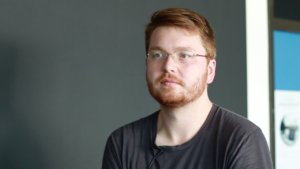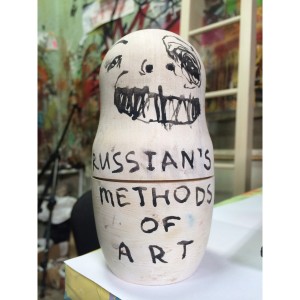Very early on I became very interested in performance art for a variety of reasons…Maybe reasons
that I did not fully understand at the beginning. I first was excited by performance art, because it
seemed to me that it was the one territory in art where everything was possible. Anything could
become a performance. Any simple act or action could become an artwork. It was not dependent
on an object, it was not dependent on anything else, something that happened in time. But later I
realized that what was really interesting to me, regarding performance, was the fact that it had so
much to do with the behavior of the individual and the way in which an individual interacts with
others in time and space. This is to say that what was really interesting to me from the very
beginning was the sociology of art. If your role is a policeman, then you have to basically show the
strength of a policeman, or if you are a fireman, or if you are a salesman then you have to be good
at certain things. There are certain expectations on your behavior. I thought that was really
interesting to think about when we look at art. Because art is, as I said, it’s this ambiguous territory
that really changes our perceptions somehow of acting in many ways and yet, the society that
supports art making which we normally call the art world tends to be very constrained and very
structured in how it assigns roles to each one of its participants. So, if I am an artist in the art world,
my job is to make these artworks that theoretically can change everything, or can be revolutionary,
or can attract attention to others and rise in value and attention in the world. If I am a collector, my
job is then to collect and preserve those works, if I am a curator, my job is to put them together.
There is like a lot of different jobs, or positions, or descriptions that one fulfills by adopting those
positions. So that led me to start making a number of works that, you would say, perhaps are very
meta very kind of like introspective in understanding the very process through which we value and
interpret art. The first one was a manual of contemporary art style which essentially is a social
etiquette manual for the art world that was essentially, you could say an ironic or satire, in the style
of Jonathan Swift the Irish writer, that told somebody how to behave in the art world and by doing
so, trying to uncover the ways, or the rituals that we all participate in. Rituals that sometimes are
absurd and nonsensical but then we all want to support them, or we all feel it’s necessary for us to
be part of them. And that led me to the other things that were of course connected to performance,
and as an educator, I became very interested in working with actors to participate let’s day, in
symposiums or very academic formats and see if I could actually build and direct a symposium as a
play following the conventions of the academic symposium and so forth. So basically I have always
been interested in how sociology and the social behavior as individuals help sustain and shape the
way that we experience and perceive art. You could say theoretically that if you are an artist
everything you produce is an artwork right? Which already puts you in trouble because there are
many things that many artists have done they did not consider artworks, and that maybe after they
pass away somebody comes and retroactively calls them an artwork. I think there are instances
where one needs to be very clear where the art starts and where it ends, where you are producing
something that is framed, literally but also conceptually you know? As ‚here is the artwork, ‚ you
know? Here is where the art starts and where it ends. But I think that there are instances that are
required of us when we have to basically create things that might not have boundaries that way. So
coming from the perspective of an educator I ask myself, what kind of art could one make, or should
one make that doesn’t have those kinds of dependencies, that it can only make sense when you
understand the context that it is criticizing. Or it can only make sense when you are inside an art
gallery or a museum for it to be made. And that was, I think, my impulse at least for the kind of work
I started producing later which now people are calling socially engaged art. Which was essentially an
attempt to produce experiences and actions that are collective, that are social in a context that may
or may not be attached to an art context. Basically existing outside of the sphere of art physically, but
maybe not conceptually. In other words, I would make a school, or I would teach a workshop, or I
would be doing a collaboration with a community, or would do a documentary project. How do you
really define an artwork and an artist? I am essentially producing something that at times can be seen
as art, but it doesn’t always have to be art. It can have a double identity. It can function in a number
of registers. It doesn’t really need ultimately to be called an artwork for it to have a meaning. Or at
least those are the kind of things that I feel are most important to me.

















